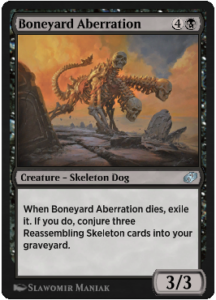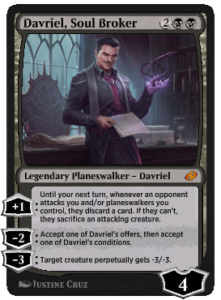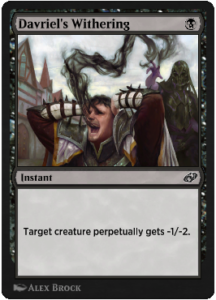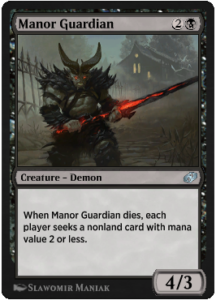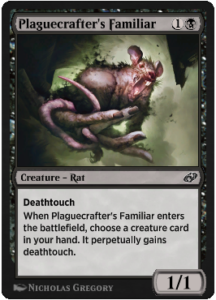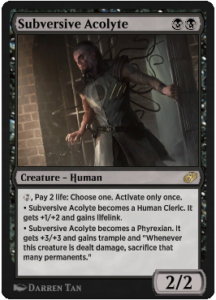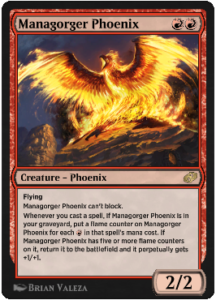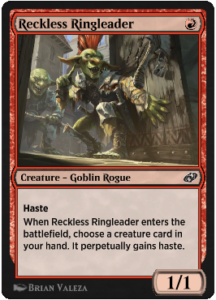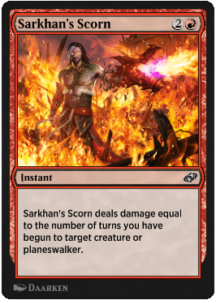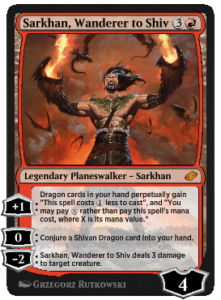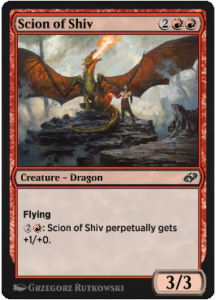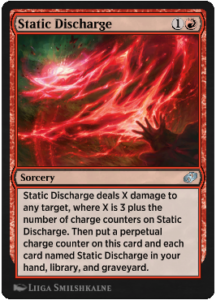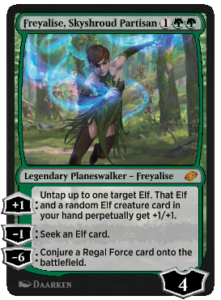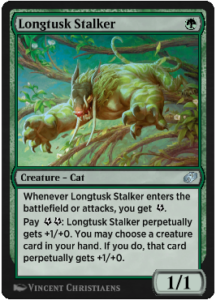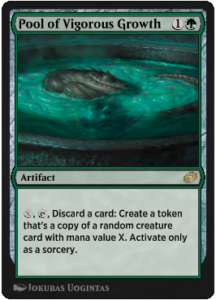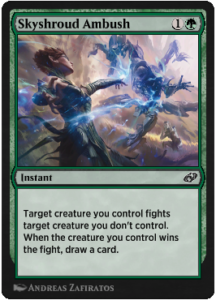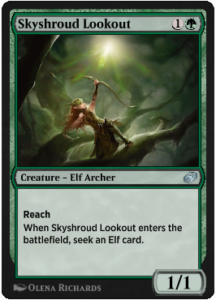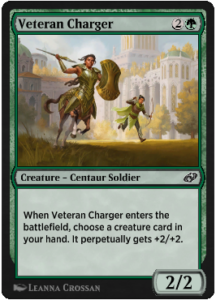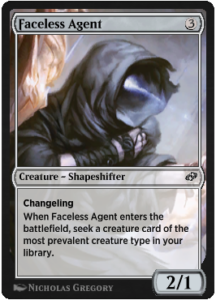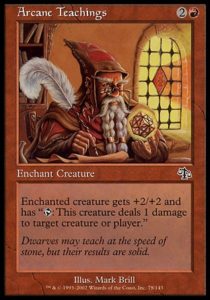Jumpstart: Historic Horizons releases on Magic Arena this week. It introduces 31 Arena-exclusive cards designed specifically for digital play. Today, we conclude our review of these designs.
Part 1 covered white and blue cards. We also discussed the difference between aspirational proactive cards (like Benalish Partisan) and reactive debuffing cards (like Baffling Defenses), the importance of excitement versus utility (see Tome of the Infinite and Shoreline Scout), and whether all these designs really need to be digital (Kiora, the Tide’s Fury). We’ll reference those ideas today as we finish our review.
With that, on to black!
Hey, it’s Bone Rattler! But a little bit weaker. The concept is cool, it’s technically doable in paper (but substantially cleaner digitally), and there are a variety of ways to employ overfilling your graveyard. There’s a lot to like here and nothing overly complicated about it.
I have a minor qualm, and it’s the same I had with Wingsteed Trainer: rate. Not only are the set’s digital mechanics tame by Wizards’ own admission, but its cards also trend towards a conservative power level. Jumpstart: Historic Horizons was hyped to change Historic as drastically as did the Mystical Archives and the original Jumpstart, yet so many look like Limited-only cards rather than viable contenders in Arena’s most powerful Constructed format.
Now, that’s ideal for the actual gameplay of Jumpstart: Historic Horizons and probably better for the health of Historic, so it’s not an issue. But it does temper my excitement for so many of these designs—I didn’t enjoy Jumpstart on Arena the first time, so it’s doubtful I’ll play much with or against a majority of its new designs. That’s a little sad, but not every product is meant for me (even if that means some cards I’d like to play with get left by the wayside).
I love this.
But before diving into the actual design, let’s talk rules templating. It’s not the sexiest topic, but Davriel’s -2 breaks a fundamental rule about how Magic cards are worded (aside from outliers like Urza, Academy Headmaster and Whimsy). Magic is a paper-focused game with significant tournament play, so Magic cards have to describe exactly how they function. Making sure each card works as intended alongside 25,000 other cards can come at the cost of brevity (Dragon’s Fire) or even coherence (Stalking Yeti). Digital games have gone a different direction, ambiguously wording some cards. This makes their rules text brief and thematic, though you may need to play with (or research) them to understand exactly how they function. Davriel embraces this paradigm with a thematic yet mystifying boon—you pick one good thing from three random options and one bad thing in the same way. But if you want to know in advance what he could possibly do, you need to check the card image gallery to see all eight offers and all eight conditions.
I like what this card does. It carves out a specific mechanical theme for Davriel beyond his Liliana-esque Davriel, Rogue Shadowmage. It makes him feel like the diabolist he is, brokering demonic bargains that you pay for. He protects himself (albeit not well with his +1), his -2 is effectively his ultimate (which is kind of awesome, given that it’s his middle ability), and he provides a possible toolbox of options through his deals.
I don’t mind him perpetually giving a creature -3/-3 in the abstract, but it did get him banned from Historic Brawl. Would it have been so bad if he instead Conjured a Mire’s Grasp (or new more thematic card) onto a creature? It’d have the same effect the vast majority of the time, provide aspirational synergies (since he’s giving you enchantment), and not hate on Magic’s most popular Constructed format.
I’ve talked in Part 1 why I don’t think that reactive spells (especially Perpetual removal) are the ideal direction for digital-only designs and how surprising it is that JHH’s 31 new card slots contain so many of these cards. So instead, let’s talk about what effect Davriel’s Withering is likely to have.
In most cases, Davriel’s Withering is slightly stronger than Disfigure and Dead Weight, cards which see fringe play. It lacks Dead Weight‘s recursive potential with cards like Lurrus of the Dream-Den and Sun Titan, but it combines the best of both cards into one. That’s not bad as far as it goes. Most of the time, this should be the same as Disfigure—it removes a creature and that’s that. Theoretically, it’s an answer to problematic recursive creatures like Cauldron Familiar, but it’s not like such decks have a card time sacrificing creatures.
I’m lukewarm on Davriel’s Withering. I appreciate that it provides another option between Fatal Push, Bloodchief’s Thirst, and our aforementioned options. But that’s a Spike choice, determining the ideal option from an array of similar choices. We’re seeing a lot of those, and not as many aspirational cards for Historic or even Jumpstart play.
I can’t immediately evaluate Manor Guardian, and I really like that. While Seek is akin to Cascade where you can hack your deck to always find what you want, here you have to both jump through a hoop (playing and losing the demon) and have a two drop combo piece while also dealing with your opponent finding their best two-mana spell as well. Perhaps this works best as a fair aggro creature that punishes opponents for not being able to deploy all their cards in time.
This card is an open-ended question, and I like that. I wish a higher percentage of J:HH cards were.
And with that, we’re going to speed through most of the remaining cards. Most of them follow similar design veins as previous cards, so for the sake of expediency we’ll reference them rather than repeat what’s already been said.
I really like Leonin Sanctifier. I like Plaguecrafter’s Familiar even more. There are so many ways to creatively use Deathtouch, both fair and powerfully unfair.
As with Kiora, the Tide’s Fury, this is a barely a digital-only card. I appreciate the modality—both options are solid and the callback to Phyrexian Negator is fun—but how often is this creature going to be returned to the battlefield for it being a Perpetual change to matter? And when it does, how often would you rather be able to switch it to the other mode?
If this literally transformed into two different cards, each with different art, that might feel better. But it wouldn’t change the actual design.
While Davriel has crisp, ambiguous templating, Managorger Phoenix reads like a Future Sight card. There’s a lot going on here. At its core, it’s an aggressive creature that recurs itself in a fair way. It’s got a nice deckbuilding constraint in devotion to red and is a little aspirational, though I realize I’m not sure exactly how it works.
If the counters reset when it returns to the battlefield (as is the case for all non-digital cards), then you need ten red mana symbols to recur it twice—that’s not very feasible. On the other hand, if this just keeps coming back with any spell after its first rebirth, this could be a serious contender. I assume it’s the weaker version, but if so, it’s a good reminder of how confusing it can be to combine Perpetual and non-Perpetual effects on the same card.
Setting aside comprehension issues, I really enjoy this. It’s a creature for which Perpetual buffs actually matter, since it’s designed to bring itself back. I’d love to see more such cards in the future.
I love this. While the other Perpetual boon creatures set up potential combos, Reckless Ringleader is designed to smash face. It’s a nice clean card that can satisfy Spike as well as Tammy and Jenny. A home run in my book.
This feels like the perfect removal spell for a digital Limited format. It scales well, going from an already playable (if unexciting) option on turn 3 to Doom Blade shortly thereafter. This is a unique implementation of digital-only design (it’s doable in paper but Control Win Condition isn’t the easiest card to play with) and makes me excited for the eventual Arena-only draft environment.
This is a neat twist on Sarkhan, Fireblood. He generates mana (in a way that’d be nonsensical in paper) and dragons (ditto). Plus, this Sarkhan protects himself. I appreciate his use of history, though Shivan Dragon is more than a little bit behind the times. Overall, it feels fine—a nice balance of zany, self-synergistic design and power level restraint.
All that said, the name is a little meh. Makes me imagine Sarkhan aimlessly wandering. He finds a tattered Beta Shivan Dragon, remembers how far it has fallen, and casts Sarkhan’s Rage to fully express his disapointment. “Wanderer” and “screaming dragonfire hands” don’t mesh in my mind.
Permanent Firebreathing is cool! Setting aside the low power level, this is a novel yet simple use of Perpetual. As with Sarkhan’s Scorn, this design makes me excited for a Limited format.
Yes, 99% of the time, this is identical to giving itself +1/+0 counters, but those haven’t existed since Magic’s earliest years.
Neat! It’s Kindle with wordier templating but better gameplay. Not only is it a Volcanic Hammer that gets better with each copy you draw, but you can employ effects like Archaeomancer to generate even more value. While the templating is clunky, this is a hit in my book.
I just wish this charged up other copies “everywhere” so it’d work with Sea Gate Stormcaller and Dualcaster Mage.
While the other planeswalkers seem fairly conservative in their designs, Freyalise, Skyshroud Partisan does not. She protects herself, generates card advantage, and on her uncontested third turn, might just win the game. There’s a chance she single-handedly puts Elves much higher on the tier list.
Setting aside power level, I love that she has three simple effects, each of which employs one of the three new mechanics. I do wonder exactly what distinguishes her mechanically from Tyvarr Kell, but given that Tyvar’s alive and she’s dead, that’s probably not a problem.
If Longtusk Cub is a young Longtusk, I guess a toddler is called a Stalker?
This is an interesting take on an aggressive one drop. It attacks as a 2/1 (and probably won’t live the next two turns to become a 3/1) and mildly buffs a creature in your hand. I’m not sure there’s enough support for a Historic Energy aggro deck, but I like where this is going. Though it is odd that it’s a “may” ability. Generally, abilities that are all-upside except in very niche situations are always “musts” specifically to minimize clicks in digital. I wonder why they bucked that trend here.
What’s that? A card that lets you play Momir Basic? And it’s more of a Tammy card than a Spike card? I love everything about this.
As with Davriel, Skyshroud Ambush uses contemporary digital templating and is ambiguous. “Wins the fight” presumably means your creature lives and theirs doesn’t. That’d be a mess to actually write out with a delayed trigger.
I don’t love it when removal also draws a card—stapling a reward onto an already desirable effect isn’t necessary and can snowball. Doing so for just two mana and at instant speed are each especially dangerous. This shouldn’t do any damage to Historic, but it’s the kind of design that I don’t want to see in the eventual digital Limited expansion (or frankly any expansion).
It’s Elvish Visionary that 50% of the time finds you a better card and the rest of the time has Reach to compensate for not drawing you a land or Glimpse of Nature. Between this and Freyalise, it definitely looks like Historic elves are intended to be a thing.
Power level aside, I appreciate that Skyshroud Lookout is meant to play fairly. You play it in a deck with lots of Elves so it can Seek any of them, rather than hack your deck to hit your only target.
This is the final card in the Perpetual handbuff cycle alongside Leonin Sanctifier, Mentor of Evos Isle, Plaguecrafter’s Familiar, and Reckless Ringleader. It’s a slightly broken cycle, since unlike the other four, this provides stats rather than a keyword. I understand that Hexproof is too dangerous to share while Vigilance, Trample, and Reach are all too weak, so there’s no ideal keyword to give out. But a raw stat boost is much easier to gain than a keyword.
This is the kind of card I’d be happy playing with in draft and Jumpstart, but even then, I’m less enthusiastic about it compared to the rest of the cycle.
Our final desgin, Faceless Agent is a simple design with only slightly confusing templating. Ostensibly, this is an all-purpose Tribal card that slots into any deck. In practice, this might be the mostly easily hacked Seek card. The next time there’s a card like Thassa’s Oracle, this can serve as an additional copy.
I wonder if this design would be better or worse if it were more open-ended and just had “Seek a creature card.” Yes, it’d be just as easy to hack in single-creature decks. But is it better having a small amount of control (and never Seeking Craterhoof Behemoth when you just need Elves) or having no control and never worrying about the exact composition of your deck at all times?
And with that, we’ve hit all 31 new designs in Jumpstart: Historic Horizons. There’s a good variety to the kinds of decks, from wacky cards like Tome of the Infinite to Historic-focused cards like Freyalise, Skyshroud Partisan. I’m looking forward to seeing how these play out in Jumpstart, as well as which ones make waves in Historic. It’s been a treat getting to review Magic’s first foray into a deep well of future design space.
Later today we get to preview next year’s catalogue of offers. Here’s looking forward to that, two new Innistrads of designs, and much more.
And, as always, thanks for reading.
Zachary Barash is a New York City-based game designer and the commissioner of Team Draft League. He designs for Kingdom Death: Monster, has a Game Design MFA from the NYU Game Center, and does freelance game design. When the stars align, he streams Magic (but the stars align way less often than he’d like).

